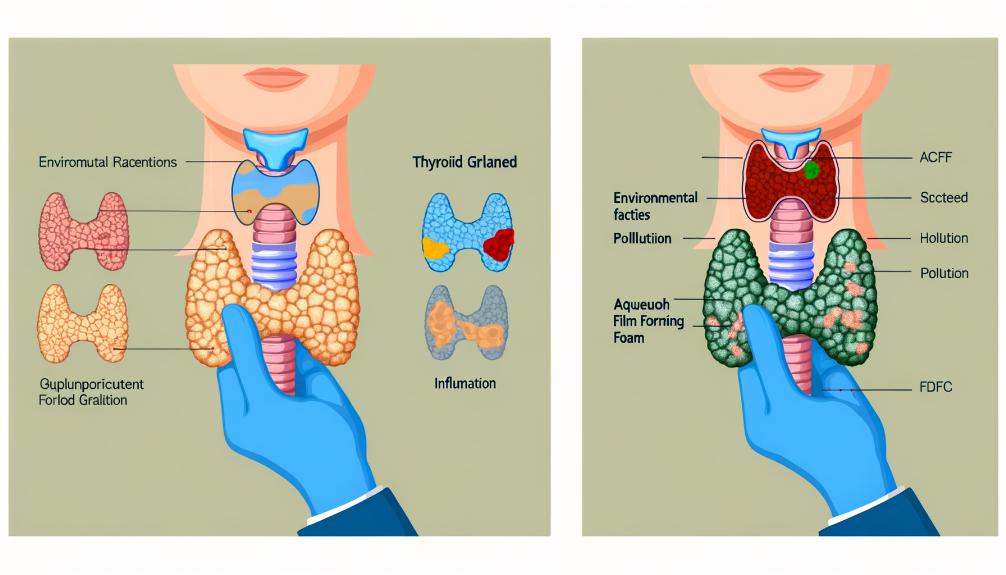Thyroiditis: Differentiating AFFF-Related Cases
We're addressing the challenge of differentiating AFFF-related thyroiditis cases, a condition increasingly linked to PFAS chemical exposure. Investigations show that PFAS, components of AFFF firefighting foam, disrupt the thyroid hormone system, leading to conditions like Hashimoto's thyroiditis. Victims face crucial symptoms and diagnosis hurdles, underlining the importance of specialized care and targeted treatment strategies. Legal support becomes essential, ensuring those affected can navigate compensation claims effectively. For military firefighters and others at high exposure risks, understanding these connections and symptoms is crucial for early detection and intervention. Our continued exploration offers insights into preventive measures and legal frameworks designed to support affected individuals further.

Key Takeaways
- AFFF-related thyroiditis often presents with unique symptoms due to PFAS exposure.
- Blood tests and ultrasound imaging are critical for distinguishing AFFF-related thyroiditis from other types.
- Individuals with a history of AFFF exposure, especially military firefighters, are at higher risk.
- A clear correlation exists between PFAS chemicals in AFFF and alterations in thyroid hormone levels.
- Preventive measures and early detection are key in managing thyroid issues from AFFF exposure.
Understanding AFFF

Aqueous Film Forming Foam (AFFF) has been a cornerstone in firefighting since its development in 1966, but we're now grappling with its environmental and health implications due to the PFAS compounds it contains. These substances, known for their resistance to degradation, have been integral in extinguishing fires, especially in military settings where the risk of fuel-based fires is significant. However, the very properties that make PFAS compounds so effective in firefighting have also led to widespread concern over their potential to cause harm.
The exposure to PFAS through AFFF, particularly among firefighters, has raised alarms regarding the health risks associated with these chemicals. Significantly, PFAS compounds are recognized as endocrine disruptors, capable of interfering with the body's hormonal systems. This disruption is especially concerning for thyroid function, with evidence suggesting a link between PFAS exposure and an increased risk of thyroid disease. The thyroid gland plays a vital role in regulating metabolism, and its impairment can lead to a host of health issues.
Given the potential for PFAS in AFFF to bioaccumulate in the body, understanding these health risks is vital. For those in the firefighting profession, especially within the military, this concern is not theoretical but a daily reality. The implications of prolonged exposure to these chemicals underscore the need for stringent regulations and effective cleanup methods to mitigate the health risks associated with AFFF. As we continue to rely on AFFF for firefighting, addressing these environmental and health challenges becomes essential for protecting those on the front lines and the communities they serve.
PFAS Chemical Properties
We're now turning our attention to the chemical properties of PFAS, particularly focusing on their stability and environmental persistence. These compounds, integral to AFFF, are notorious for not breaking down easily and accumulating in the natural world, posing significant challenges for evaluating efforts. Understanding these properties is crucial for evaluating the long-term impact on ecosystems and human health, especially for professionals frequently exposed to these substances.
PFAS Stability Concerns
The remarkable stability of PFAS compounds, which resist environmental degradation, raises substantial concerns regarding their impact on both ecosystems and human health. These compounds, integral to AFFF formulations due to their surfactant properties, exhibit a worrying chemical stability. This trait allows them not only to persist in the environment but also to bioaccumulate in organisms, leading to potential long-term health risks. Understanding the chemical stability of PFAS is important for evaluating the risks of environmental contamination they pose. Consequently, stringent regulatory measures are necessary to mitigate these risks. The challenge lies in balancing the use of AFFF for its intended purposes while addressing the health hazards associated with PFAS exposure, highlighting the need for thorough strategies to manage their impact.
Environmental Persistence Impact
PFAS compounds, integral to AFFF formulations, exhibit an alarming level of environmental persistence, making them a significant concern for ecosystems and human health alike. These substances, known for their degradation resistance, linger in the environment, leading to their widespread detection in water, soil, and living organisms. We're seeing that their stability and surfactant properties not only facilitate their bioaccumulation but also raise long-term exposure risks, directly impacting thyroid health. It's evident that stringent regulatory regulations are essential to mitigate the environmental and health hazards posed by PFAS compounds. Understanding the intricate balance between their utility in AFFF and the imperative to protect public health drives the need for informed regulatory approaches, prioritizing both safety and environmental integrity.
Thyroid Function Basics

As we delve into the basics of thyroid function, it's essential that we grasp the key roles that thyroid hormones play in our body's metabolism, growth, and development. We'll also explore common thyroid disorders, which arise from imbalances in these hormones, and the mechanisms that regulate thyroid activity, including the critical function of TSH. This comprehension is fundamental as we analyze how AFFF exposure potentially disrupts these processes, leading to thyroiditis in affected individuals.
Thyroid Hormones Overview
Understanding thyroid hormones, including T3 and T4, is vital to grasping how they regulate essential functions such as metabolism, growth, and energy production in our bodies. Produced by the thyroid gland, these hormones play a pivotal role in maintaining body temperature, heart rate, and overall organ functionality. TSH, or thyroid-stimulating hormone, secreted by the pituitary gland, orchestrates the release of T3 and T4, ensuring our physiological systems operate smoothly. However, imbalances in these hormone levels can precipitate a range of symptoms, from weight fluctuations and fatigue to mood swings, signaling potential thyroid disorders. It's essential we comprehend their role, as this knowledge is fundamental in effectively diagnosing and managing thyroid-related imbalances and symptoms, ensuring excellent health outcomes.
Common Thyroid Disorders
Having explored the role of thyroid hormones like T3 and T4, we'll now examine the common disorders that disrupt their balance, including hypothyroidism and hyperthyroidism. These conditions, along with Hashimoto's disease and Graves' disease, embody the spectrum of thyroid disorders stemming from irregularities in thyroid hormone production and regulation. Symptoms vary widely, from weight fluctuations and fatigue to muscle weakness and mood changes, underscoring the need for an accurate diagnosis. Grasping the essentials of thyroid function is pivotal for identifying these disorders. Given the nuanced nature of thyroid hormone production, conditions like Hashimoto's and Graves' disease highlight the complexity of maintaining thyroid function. Consequently, ensuring an accurate diagnosis is critical for effective treatment and management of these conditions.
Thyroid Regulation Mechanisms
To grasp how our bodies maintain overall well-being, it's essential to explore the mechanisms regulating thyroid function. The thyroid gland plays a pivotal role in our metabolism, growth, and development through precise hormone secretion. Thyroid-stimulating hormone (TSH) from the pituitary gland is vital for controlling thyroid hormone production. The primary hormones produced, thyroxine (T4) and triiodothyronine (T3), are indispensable for energy metabolism, temperature regulation, and organ function. The hypothalamus-pituitary-thyroid axis intricately maintains this hormonal balance, ensuring our physiological functions operate smoothly. Understanding this axis helps us appreciate the complexity of hormone production and the vital role the thyroid gland plays in our overall health.
AFFF and Thyroid Disruption

The exposure to Aqueous Film Forming Foam (AFFF) poses a significant risk of thyroid disruption in firefighters, primarily due to the PFAS compounds known to accumulate in thyroid cells. These substances, renowned for their fire-extinguishing efficiency, have unfortunately been linked to thyroid disease related issues, particularly among firefighters and military personnel frequently exposed to AFFF at military bases. The specific PFAS compounds found in AFFF, such as PFOS, PFOA, and PFHxS, act as endocrine disruptors, intricately impacting the thyroid hormone system and potentially leading to thyroid dysfunction.
Our understanding of how PFAS exposure and thyroid health are connected is essential, especially when considering the elevated risks for those in close contact with these chemicals. Studies have highlighted correlations between PFAS chemicals and alterations in thyroid hormone levels, suggesting a tangible link to conditions like Hashimoto's thyroiditis, an autoimmune disorder resulting in thyroid gland inflammation. This connection underscores the importance of vigilance and preventive measures for individuals at risk.
In addressing the health risks associated with AFFF, it's crucial that we focus on the broader implications of PFAS exposure and its capacity to disrupt thyroid function. The evidence pointing to a relationship between PFAS exposure and thyroid issues necessitates a proactive approach to mitigate these risks, particularly for those like firefighters and military personnel, who are disproportionately affected. As we explore further into the impact of PFAS on the thyroid, our goal remains to safeguard the health and well-being of those exposed to these hazardous chemicals, ensuring they receive the necessary support and information to prevent thyroid disease related complications.
Research and Studies Overview
We'll now explore the research and studies that shed light on AFFF-related thyroiditis, underscoring the importance of distinguishing its symptoms from other thyroid conditions. The recent scientific investigations into the effects of PFAS exposure on thyroid health have been pivotal. These studies aim to unravel the complex relationship between AFFF exposure and the onset of thyroiditis, focusing on the unique clinical presentations that this form of thyroiditis may exhibit. Unlike other thyroid disorders, AFFF-related thyroiditis cases are believed to present a set of unique symptoms, primarily due to the distinct chemical properties of PFAS.
A closer look at the research reveals that understanding the precise impact of PFAS exposure is essential for the accurate diagnosis and subsequent treatment of AFFF-related thyroiditis. The goal of these scientific investigations is not only to establish a clear link between PFAS exposure and the development of thyroiditis but also to understand the distinct characteristics that differentiate AFFF-induced thyroiditis from other types. This knowledge is crucial in developing targeted treatment strategies that address the specificities of AFFF-related thyroiditis.
Legal Framework and Compensation

Traversing the legal terrain for AFFF-related thyroiditis cases requires expert legal assistance to guarantee victims receive the compensation they're entitled to. The journey to justice starts with thorough documentation of medical records and symptoms, underscoring the pivotal role these records play in substantiating claims related to AFFF exposure. It's not merely about compiling symptoms; it's about painting a detailed picture that vividly illustrates the impact of AFFF on our health, specifically thyroid disorders.
Specialized legal assistance steps into this complex scenario to navigate the intricate legal process surrounding AFFF-related cases. These professionals don't just offer legal support; they're instrumental in emphasizing the broader public health issue, connecting the dots between AFFF exposure and the prevalence of thyroid disorders. Their expertise ensures that every claim is backed by solid evidence, including employment and military records, which are critical for seeking justice and compensation.
Moreover, the role of legal assistance transcends beyond the courtroom. It's about proving the link between AFFF exposure and thyroid disease, ensuring accountability from those responsible, and securing the support victims desperately need. This legal journey is not just about compensation; it's about recognition and support for those affected by AFFF-related thyroid disorders.
Diagnosis and Treatment Challenges
Diagnosing and treating thyroiditis, particularly when linked to AFFF exposure, presents unique challenges, including atypical symptoms that often overlap with other conditions. Civilians exposed to these substances are at a high risk of developing thyroid disease due to the atypical presentation of subacute thyroiditis (SAT). This fact complicates the diagnostic process, as symptoms like acute headaches can easily be mistaken for other conditions such as meningitis.
Blood tests and ultrasound become essential tools in accurately diagnosing SAT, helping to distinguish it from other thyroid disorders. It's essential for us to rely on these diagnostic methods to guarantee that those at risk, especially civilians unknowingly exposed to hazardous substances, receive the correct diagnosis. The American Thyroid Association's guidelines become crucial in our approach, recommending NSAIDs for mild cases of SAT and glucocorticoids for more severe presentations.
Understanding the impact of thyroid hormone levels on headache management is crucial, especially when dealing with atypical cases of SAT. The challenge lies in balancing the treatment to address both the thyroid function and the unique symptoms presented by the patient. This nuanced approach is necessary due to the varied symptomatology and the risk factors associated with AFFF exposure.
Military Firefighters Risk

Moving beyond the general challenges in diagnosing and treating thyroiditis, it's important to focus on the specific risks faced by military firefighters due to exposure to AFFF. The presence of PFAS in AFFF is a significant concern, as these toxic compounds are linked to thyroid diseases, including Hashimoto's thyroiditis and hypothyroidism. Military firefighters are at a higher risk of developing these conditions due to their repeated exposure to AFFF during training and firefighting activities.
Studies have highlighted that over 40,000 cases of thyroid disorders have been identified in active military members over a decade, with hypothyroidism being the most prevalent. This is particularly alarming as rates of thyroid disorders were remarkably higher in non-Hispanic white service members and Air Force personnel, pointing to a clear link between PFAS exposure and thyroid disease. The toxic exposure from PFAS found in AFFF raises the military firefighters' risk of suffering from these health issues significantly.
Given these findings, it's essential for military firefighters and veterans to receive early diagnosis and treatment for thyroid disorders. This approach is crucial to mitigate the long-term health impacts of PFAS exposure. Our understanding of the relationship between exposure to AFFF and the development of thyroid diseases continues to evolve. It underscores the need for ongoing research and tailored healthcare strategies to address the unique risks military firefighters face. This situation demands attention and action to protect those who serve from the unintended consequences of their service.
Impact on Pregnancy
We must also consider the significant impact that maternal exposure to AFFF-related PFAS compounds during pregnancy has on fetal development. These compounds, known for their presence in firefighting foams, have been linked to various health concerns, particularly regarding thyroid function. When expectant mothers are exposed to these chemicals, the PFAS compounds can cross the placental barrier, directly affecting the thyroid function of developing fetuses. This is an essential aspect to understand, as thyroid hormones play a critical role in the growth and development of fetuses.
The thyroid disruption from AFFF exposure during pregnancy does not only pose a risk at the developmental stage but may also increase the likelihood of thyroid-related issues in offspring. This includes an increased risk of thyroid dysfunction, which can manifest as various health problems in children as they grow. Research has suggested a correlation between maternal PFAS exposure and altered thyroid hormone levels in newborns, further underscoring the potential long-term effects of such exposure.
Understanding the link between maternal exposure to AFFF-related PFAS compounds and the health of developing fetuses is essential. It's not just about the immediate effects but also how such exposure might predispose children to thyroid dysfunction later in life. This places a significant emphasis on the need for awareness and preventive measures during pregnancy to protect both mothers and their unborn children from potential harm.
Seeking Legal Assistance

For those impacted by AFFF exposure and dealing with thyroid disorders, seeking legal help is a crucial step toward obtaining compensation. Managing AFFF-related claims can be intricate, given the detailed nature of establishing a direct link between toxic exposure and thyroid disorders. However, specialized attorneys, particularly those from firms like Atraxia Law, are skilled at handling such cases. They bring a wealth of experience in toxic exposure and personal injury claims, making them invaluable in the pursuit of justice and compensation.
Submitting detailed employment and medical records plays a pivotal role in the eligibility evaluation for AFFF-related legal claims. This documentation is essential in establishing the correlation between AFFF exposure and the onset of thyroid disorders. Specialized attorneys are equipped to guide affected individuals through this process, ensuring that all necessary evidence is accurately presented.
Furthermore, the financial barrier to seeking legal help is minimized, as no fees are charged unless compensation is obtained. This contingency-based approach makes legal support accessible to those impacted by AFFF exposure, eliminating financial risk from the equation.
Preventive Measures
In addressing the prevention of AFFF-related thyroid issues, we're turning our attention towards three critical areas: risk factor reduction, regular health screenings, and lifestyle and diet adjustments. By focusing on these points, we aim to mitigate the health risks associated with exposure to PFAS-containing firefighting foams. It's our belief that through informed choices and proactive measures, we can significantly decrease the occurrence of thyroid diseases linked to AFFF use.
Risk Factor Reduction
Reducing exposure to AFFF-related PFAS compounds is essential in mitigating the risk of thyroiditis. By embracing alternative firefighting foams devoid of PFAS, we're taking an important step toward safeguarding our health from thyroid disorders. Implementing stricter guidelines on AFFF use can greatly curtail environmental and health implications, minimizing the risk of PFAS contamination. Additionally, understanding the molecular mechanisms by which PFAS in AFFF influences thyroid function is crucial. This knowledge paves the way for targeted regulatory actions aimed at risk reduction. Considering the adverse pregnancy outcomes linked to maternal PFAS exposure, it's clear that thorough preventive measures are not just beneficial but necessary. By prioritizing these strategies, we're addressing the pivotal environmental factors contributing to the onset of thyroid diseases.
Regular Health Screenings
While focusing on minimizing exposure to harmful substances is important, we also can't overlook the significance of regular health screenings in detecting thyroid disorders early, especially for those exposed to AFFF. Firefighters, in particular, should undergo specific thyroid function tests routinely to monitor their thyroid health. These screenings are essential for identifying AFFF-related thyroid issues promptly. By incorporating routine screenings into their health care regimen, we can greatly aid in managing thyroid diseases linked to AFFF exposure. Keeping detailed medical records to determine levels of exposure and subsequent changes in thyroid function tests is essential. This proactive approach allows for timely intervention and treatment, highlighting the critical role of regular health check-ups in the early detection and management of thyroid conditions.
Lifestyle and Diet Adjustments
We can mitigate thyroiditis symptoms significantly by making mindful lifestyle and diet adjustments. Adjusting dietary iodine and limiting goitrogenic foods like soy, cabbage, and kale support thyroid health, important for those concerned about AFFF exposure and its link to thyroid disorders. Incorporating selenium-rich foods can reduce inflammation, essential in managing thyroid conditions amidst endocrine disruptors and PFAS concerns. Moreover, for individuals with autoimmune thyroiditis, reducing gluten may offer benefits. Regular exercise and stress management techniques not only improve thyroid function but also enhance overall well-being. These steps, coupled with health monitoring, form a robust defense in maintaining thyroid health and preventing thyroid disease, crucial in environments with potential AFFF exposure.
Symptoms and Early Detection
Identifying the symptoms of thyroiditis early, such as neck pain, fatigue, and weight fluctuations, can greatly improve prognosis and treatment outcomes. When we consider the specific context of AFFF exposure, particularly among military firefighters, the stakes are even higher. AFFF, or aqueous film-forming foam, has been linked to various thyroid disorders due to its composition of endocrine disruptors. These substances can interfere with thyroid function, leading to significant health issues if not caught early.
Early detection is pivotal in managing thyroiditis effectively. Monitoring thyroid hormone levels and conducting ultrasound imaging are key initial steps. Additionally, palpitations, heat intolerance, and hair loss are symptoms that shouldn't be overlooked. Blood tests for thyroid antibodies offer a more refined diagnostic tool, helping to pinpoint specific types of thyroiditis linked to AFFF exposure.
It's important to understand that thyroid disorders, especially those influenced by AFFF exposure, can lead to severe complications if not addressed promptly. Thyroid storm or permanent thyroid damage are among the potential risks. Heightened awareness and early detection strategies are essential. For military firefighters and others at risk of AFFF exposure, regular screenings for thyroid function and antibodies can be lifesaving measures.

This post has been generated by AI and was not reviewed by editors. This is Not legal advice. Please consult with an attorney.




